Enjoying the content on 3QD? Help keep us going by donating now.
Category: Recommended Reading
If critique could kill, neoliberalism would long be dead
Blake Smith in The Hedgehog Review:
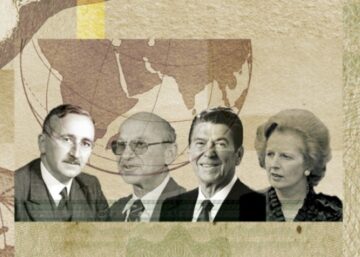 If critique could kill, neoliberalism would long be dead. So far, however, neither decades of intellectual opposition from the left and right nor the past decade of populist politics has done more than erode some measure of neoliberalism’s ideological preeminence. Talk from the right of “pro-family” policies, such as tax breaks and subsidies for having children, or moves by the Biden administration to secure domestic manufacturing of critical high-technology goods may hearten neoliberalism’s foes (even as they further blur the ideological map of American politics). Neither, however, offers anything like a consensus to replace the vision that, since the crises of the 1970s, has, with whatever degree of discontent, guided our collective thought and action.
If critique could kill, neoliberalism would long be dead. So far, however, neither decades of intellectual opposition from the left and right nor the past decade of populist politics has done more than erode some measure of neoliberalism’s ideological preeminence. Talk from the right of “pro-family” policies, such as tax breaks and subsidies for having children, or moves by the Biden administration to secure domestic manufacturing of critical high-technology goods may hearten neoliberalism’s foes (even as they further blur the ideological map of American politics). Neither, however, offers anything like a consensus to replace the vision that, since the crises of the 1970s, has, with whatever degree of discontent, guided our collective thought and action.
Half a century ago, as the OPEC oil embargo and an unprecedented combination of inflation and unemployment disrupted the shared understanding of economics and politics that had oriented Western elites after World War II, neoliberalism became identified with a range of tactics for restoring economic growth. Understanding what neoliberalism is, and what its relation to liberalism might be, has been a central task for intellectuals ever since.
More here.
Enjoying the content on 3QD? Help keep us going by donating now.
Man survives with titanium heart for 100 days – a world first
Smriti Mallapaty in Nature:
 An Australian man in his forties has become the first person in the world to leave hospital with an artificial heart made of titanium. The device is used as a stopgap for people with heart failure who are waiting for a donor heart, and previous recipients of this type of artificial heart had remained in US hospitals while it was in place.
An Australian man in his forties has become the first person in the world to leave hospital with an artificial heart made of titanium. The device is used as a stopgap for people with heart failure who are waiting for a donor heart, and previous recipients of this type of artificial heart had remained in US hospitals while it was in place.
The man lived with the device for more than three months until he underwent surgery to receive a donated human heart. The man is recovering well, according to a statement from St Vincent’s Hospital in Sydney, Australia, where the operations were conducted. The Australian is the sixth person globally to receive the device, known as BiVACOR, but the first to live with it for more than a month. “This is certainly an important development in the field,” says Julian Smith, a cardiac surgeon at the Victorian Heart Institute at Monash University in Melbourne, Australia.
More here.
Enjoying the content on 3QD? Help keep us going by donating now.
Thursday Poem
We
are out-of-focus and we are
flesh. Some call this panting
love. So much is about
breath. Small at night. Large
in our wakefulness, largest
when the body mates, when the moment
rides on its own rising. Only then
are we safe. —from
ourselves. —Our fears, our hates. Blood.
A little dust and a little water.
Sun and moist seed
shivers and climbs. Call this blind,
call this a movement toward light.
by Mark Irwin
from Quick, Now, Always
BOA Editions, Ltd. Brockport, NY, 1996
Enjoying the content on 3QD? Help keep us going by donating now.
Wednesday, March 12, 2025
Twenty Steven Pinker Quotes
Steve Stewart-Williams at The Nature-Nurture-Nietzsche Newsletter:
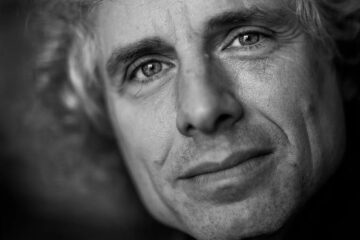 [SSW: The next quote is Pinker’s rebuttal of a common response to Judith Rich Harris’s claim that parents have little impact on their kids.] “‘So you’re saying it doesn’t matter how I treat my children?’ What a question! Yes, of course it matters… First, parents wield enormous power over their children, and their actions can make a big difference to their happiness… It is not OK for parents to beat, humiliate, deprive, or neglect their children, because those are awful things for a big strong person to do to a small helpless one… Second, a parent and a child have a human relationship. No one ever asks, ‘So you’re saying it doesn’t matter how I treat my husband or wife?’ even though no one but a newlywed believes that one can change the personality of one’s spouse. Husbands and wives are nice to each other (or should be) not to pound the other’s personality into a desired shape but to build a deep and satisfying relationship.”
[SSW: The next quote is Pinker’s rebuttal of a common response to Judith Rich Harris’s claim that parents have little impact on their kids.] “‘So you’re saying it doesn’t matter how I treat my children?’ What a question! Yes, of course it matters… First, parents wield enormous power over their children, and their actions can make a big difference to their happiness… It is not OK for parents to beat, humiliate, deprive, or neglect their children, because those are awful things for a big strong person to do to a small helpless one… Second, a parent and a child have a human relationship. No one ever asks, ‘So you’re saying it doesn’t matter how I treat my husband or wife?’ even though no one but a newlywed believes that one can change the personality of one’s spouse. Husbands and wives are nice to each other (or should be) not to pound the other’s personality into a desired shape but to build a deep and satisfying relationship.”
More here.
Enjoying the content on 3QD? Help keep us going by donating now.
‘Next-Level’ Chaos Traces the True Limit of Predictability
Charlie Wood in Quanta:
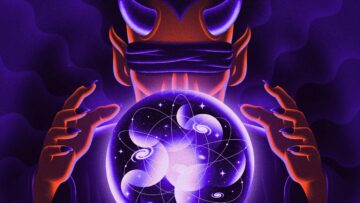 The French scholar Pierre-Simon Laplace crisply articulated his expectation that the universe was fully knowable in 1814, asserting that a sufficiently clever “demon” could predict the entire future given a complete knowledge of the present. His thought experiment marked the height of optimism about what physicists might forecast. Since then, reality has repeatedly humbled their ambitions to understand it.
The French scholar Pierre-Simon Laplace crisply articulated his expectation that the universe was fully knowable in 1814, asserting that a sufficiently clever “demon” could predict the entire future given a complete knowledge of the present. His thought experiment marked the height of optimism about what physicists might forecast. Since then, reality has repeatedly humbled their ambitions to understand it.
One blow came in the early 1900s with the discovery of quantum mechanics. Whenever quantum particles are not being measured, they inhabit a fundamentally fuzzy realm of possibilities. They don’t have a precise position for a demon to know.
Another came later that century, when physicists realized how much “chaotic” systems amplified any uncertainties. A demon might be able to predict the weather in 50 years, but only with an infinite knowledge of the present all the way down to every beat of every butterfly’s wing.
In recent years, a third limitation has been percolating through physics — in some ways the most dramatic yet.
More here.
Enjoying the content on 3QD? Help keep us going by donating now.
The Future of U.S. AI Leadership, with CEO of Anthropic, Dario Amodei
Enjoying the content on 3QD? Help keep us going by donating now.
Canada Is Spooked
Quico Toro at Persuasion:
We can give ourselves far, far more than Donald Trump can ever take away, but it will—it will take extraordinary efforts. It won’t be business as usual. We will have to do things we haven’t imagined before, at speeds we didn’t think possible. […] I know, I know that these are dark days, dark days brought on by a country we can no longer trust. We are getting over the shock, but let us never forget the lessons: we have to look after ourselves and we have to look out for each other. We need to pull together in the tough days ahead.
These lines, spoken by Mark Carney on Sunday moments after he was chosen to lead the governing Liberal Party of Canada, paint a startling picture of a suddenly unrecognizable relationship with our giant neighbor. For a leader on the cusp of becoming Canadian prime minister to just matter-of-factly assert that Canada can no longer trust the United States is geopolitics through the looking glass. Managing the fallout from this impossibility will now be the thing a Canadian prime minister has to do.
Americans, in their endless self-regard, have always vaguely figured Canadian politics must be largely about the United States. When you live in Canada—as I did from 2009 to 2024—you soon learn how silly that is.
More here.
Enjoying the content on 3QD? Help keep us going by donating now.
Wednesday Poem
Poem by Jack Kerouac —on his birthday
A Sudden Sketch Poem
Gary’s sink has a shroudy burlap
the rub brush tinwear plout
leans on right side
like a red womans hair
the faucet leaks little lovedrops
The teacup’s upsidedown with visions
of green mountains and brown lousy
Chinese mysterious up heights
The frying pan’s still wet
The spoon’s by 2 petals of flower
The washrag’s hung on edge like bloomers
I don’t know what to say
about the dishpan, the soap
The sink itself inside or what
is hidden underneath the bomb burlap
Shroudflap except two onions
And an orange old wheat germ.
Wheat meal. The hoodlatch heliograph
With the cross that makes the devil
Hiss, ah, the upper coral sensen soups
And fast condiments, curries, rices,
Roaches, reels, tin, tip, plastickets,
Toothbrushes, and armies, and armies
of insulated schiller, squozen gumbrop
Peste pans, light of Marin, pirshyar,
Magic dancing lights of gray and white
And all for verse I wrote it.
by Jack Kerouac
April 1966, McCorkle’s Shack
from— Jack Kerouac Poems All Sizes
City Lights Books, 1992
Enjoying the content on 3QD? Help keep us going by donating now.
Imposter Syndrome Isn’t a Personal Flaw. It’s a Systemic Issue
Shari Dunn in Time Magazine:
 The term “imposter syndrome” has become a cultural shorthand for self-doubt. We’re told it’s something to fix within ourselves: a nagging belief that we’re unqualified or unworthy, even when all evidence points to the contrary. Yet for many women—and especially women of color—this framing misses the mark entirely.
The term “imposter syndrome” has become a cultural shorthand for self-doubt. We’re told it’s something to fix within ourselves: a nagging belief that we’re unqualified or unworthy, even when all evidence points to the contrary. Yet for many women—and especially women of color—this framing misses the mark entirely.
In reality, what’s labeled as imposter syndrome in the workplace is often a misdiagnosis—a symptom of systemic inequities. It’s a response to environments steeped in bias, exclusion, and relentless scrutiny of the competence of women, Black professionals, and other people of color, a practice known as “competency checking.” Competency checking—whether intentional or unconscious—undermines those who challenge traditional norms of leadership and success. Imposter syndrome, however, masquerades as an internal failing, leading women to pathologize themselves rather than confront the systems perpetuating their struggles.
More here.
Enjoying the content on 3QD? Help keep us going by donating now.
Chinese Companies Rush to Put DeepSeek in Everything
Zeyi Yang in Wired:
 What do a mobile shooting game, a nuclear power plant, and a local Chinese government office have in common? In the past two months, they have all tried incorporating DeepSeek’s R1 artificial intelligence model into their businesses in an attempt to ride the wave of the homegrown tech company’s viral rise.
What do a mobile shooting game, a nuclear power plant, and a local Chinese government office have in common? In the past two months, they have all tried incorporating DeepSeek’s R1 artificial intelligence model into their businesses in an attempt to ride the wave of the homegrown tech company’s viral rise.
Ever since the Chinese AI startup became a global sensation, DeepSeek has dominated headlines in China—but the news has almost nothing to do with DeepSeek itself. Instead, companies across nearly every industry are racing to announce that they have found a way to include DeepSeek’s open source models in their corporate strategy. Some have found genuine uses for the domestic, affordable AI model with cutting-edge capabilities, while others are merely doing it for the publicity boost or to virtue-signal their national pride.
More here.
Enjoying the content on 3QD? Help keep us going by donating now.
Tuesday, March 11, 2025
Terrence Malick, or, Philosophy by Other Means
Santiago Zabala in the blog of the American Philosophical Association:
 Given the chance to become a movie director in Hollywood or a professor of philosophy at Harvard, I imagine very few of us would choose the academic life. The money and fame of being a movie director are far more tantalizing than teaching Plato, Kant, or Simone de Beauvoir. Terrence Malick chose to become a movie director instead of a philosophy professor, but not for the reasons you might think. It was not money and fame that convinced him, but the inability of philosophy courses to help “him understand himself and his place in the order of the cosmos” as Martin Woessner explained in a recent book dedicated to the great filmmaker. Although he is not the only promising scholar to ditch his dissertation and a career in academia due to philosophy’s scientific turn in the 1960s, he is probably the only one whose “entire oeuvre,” as Woessner tells us, “constitutes a philosophy by other means and is worth taking seriously as such.”
Given the chance to become a movie director in Hollywood or a professor of philosophy at Harvard, I imagine very few of us would choose the academic life. The money and fame of being a movie director are far more tantalizing than teaching Plato, Kant, or Simone de Beauvoir. Terrence Malick chose to become a movie director instead of a philosophy professor, but not for the reasons you might think. It was not money and fame that convinced him, but the inability of philosophy courses to help “him understand himself and his place in the order of the cosmos” as Martin Woessner explained in a recent book dedicated to the great filmmaker. Although he is not the only promising scholar to ditch his dissertation and a career in academia due to philosophy’s scientific turn in the 1960s, he is probably the only one whose “entire oeuvre,” as Woessner tells us, “constitutes a philosophy by other means and is worth taking seriously as such.”
Malick’s inability to pursue a career in academia reminds us—members and friends of the APA—that we must encourage and promote students who prefer wondering, and asking questions about everything and nothing, to completing narrow tasks. Malick’s films and Woessner study demonstrate it is possible (and sometimes necessary) to philosophize outside of the university’s rigid disciplinary boundaries when these questions emerge among our students. Malick’s career arguably shows us not only what has gone wrong with the teaching of philosophy today, but also how to fix it by returning it to the project of “examining our lives,” as Socrates suggested.
More here.
Enjoying the content on 3QD? Help keep us going by donating now.
The Quest for A.I. ‘Scientific Superintelligence’
Steve Lohr in the New York Times:
 Relying on an experienced team of scientists and $200 million in initial funding, Lila has been developing an A.I. program trained on published and experimental data, as well as the scientific process and reasoning. The start-up then lets that A.I. software run experiments in automated, physical labs with a few scientists to assist.
Relying on an experienced team of scientists and $200 million in initial funding, Lila has been developing an A.I. program trained on published and experimental data, as well as the scientific process and reasoning. The start-up then lets that A.I. software run experiments in automated, physical labs with a few scientists to assist.
Already, in projects demonstrating the technology, Lila’s A.I. has generated novel antibodies to fight disease and developed new materials for capturing carbon from the atmosphere. Lila turned those experiments into physical results in its lab within months, a process that most likely would take years with conventional research.
Experiments like Lila’s have convinced many scientists that A.I. will soon make the hypothesis-experiment-test cycle faster than ever before.
More here.
Enjoying the content on 3QD? Help keep us going by donating now.
Terence Tao on how we measure the cosmos
Enjoying the content on 3QD? Help keep us going by donating now.
Muskism and McCarthyism: A conversation with Corey Robin on fear in the workplace
Alan Dean and Charles Petersen at n + 1:
 The early days of the second Trump Administration have been greeted with both shock and a search for lessons from history. Journalists have turned to the Nixon Administration’s attempts to “impound” congressionally allocated funds as both a precedent for Trump’s actions and evidence of their illegality. The rollback of DEI and the targeted firings of women and Black leaders across the military and the civil service is redolent of the southern “Redemption” that brought Jim Crow to power in the 1870s and 1880s after the end of Reconstruction. Notably absent in many of these discussions is the last time mass firings and large-scale workplace intimidation occurred in the federal government: the McCarthy Era and the Second Red Scare of the late 1940s and early 1950s.
The early days of the second Trump Administration have been greeted with both shock and a search for lessons from history. Journalists have turned to the Nixon Administration’s attempts to “impound” congressionally allocated funds as both a precedent for Trump’s actions and evidence of their illegality. The rollback of DEI and the targeted firings of women and Black leaders across the military and the civil service is redolent of the southern “Redemption” that brought Jim Crow to power in the 1870s and 1880s after the end of Reconstruction. Notably absent in many of these discussions is the last time mass firings and large-scale workplace intimidation occurred in the federal government: the McCarthy Era and the Second Red Scare of the late 1940s and early 1950s.
In 2004, at the height of the war on terror, the political theorist Corey Robin published Fear: The History of a Political Idea. Among other contributions, Fear offers a searching examination of McCarthyism, showing how the Second Red Scare should be seen not simply as an aberration but an embodiment of many of the core dynamics in American politics. In 2017, at the beginning of the first Trump Administration, Robin wrote for n+1 two of the most incisive early examinations of the new presidency. Eight years later we asked Robin to help us think through the present conjuncture.
More here.
Enjoying the content on 3QD? Help keep us going by donating now.
Lady Gaga – Mayhem
Enjoying the content on 3QD? Help keep us going by donating now.
Lady Gaga’s New Album
Rich Juzwiak at Pitchfork:
 Talk about truth in advertising: MAYHEM is its own charm offensive, a massive attack of good vibes. It is a project designed to remind listeners why they fell in love with her in the first place, before the jazz belting or the traditional singer-songwriter gravitas or movie stardom. Inspiration from fiancé Michael Polansky, entrepreneur and one of the album’s executive producers, to return to her pop roots prompted an internal survey—Gaga told EW that instead of seeking to reinvent her sound, “I started to think about what makes me me? What are my references? What are my inspirations?” MAYHEM, then, isn’t the sound of someone reheating her nachos on the sly and trying to pass them off as fresh—it’s a full-on cooking show devoted to the art of nacho-reheating.
Talk about truth in advertising: MAYHEM is its own charm offensive, a massive attack of good vibes. It is a project designed to remind listeners why they fell in love with her in the first place, before the jazz belting or the traditional singer-songwriter gravitas or movie stardom. Inspiration from fiancé Michael Polansky, entrepreneur and one of the album’s executive producers, to return to her pop roots prompted an internal survey—Gaga told EW that instead of seeking to reinvent her sound, “I started to think about what makes me me? What are my references? What are my inspirations?” MAYHEM, then, isn’t the sound of someone reheating her nachos on the sly and trying to pass them off as fresh—it’s a full-on cooking show devoted to the art of nacho-reheating.
If it sounds strange to say that it’s good to have Gaga back, it’s probably because she’s never really stayed away for too long. Between her proper sixth album, 2020’s Chromatica, and MAYHEM, Gaga played her Vegas residency and toured the world; was the best thing in two bad movies, 2021’s House of Gucci and 2024’s Joker: Folie à Deux; and released a companion album for the latter, the covers-heavy Harlequin.
more here.
Enjoying the content on 3QD? Help keep us going by donating now.
Can We Solve the Parkinson’s Puzzle?
Paul Hond in Columbia Magazine:
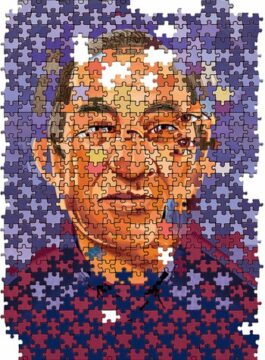 Ping-pong is not a game that lends itself well to chatter. It demands sharp focus, quick reflexes, and a light touch, and the dozen players who have gathered this Monday afternoon at PingPod, a table-tennis venue on West 99th Street, are locked in the wordless rhythms of the back-and-forth. Aside from the occasional “Nice spin!” or grunt of self-reproach, the room is filled with the hollow percussion of little white balls glancing off paddles, skipping over the tops of the black tables, and rattling across the floor.
Ping-pong is not a game that lends itself well to chatter. It demands sharp focus, quick reflexes, and a light touch, and the dozen players who have gathered this Monday afternoon at PingPod, a table-tennis venue on West 99th Street, are locked in the wordless rhythms of the back-and-forth. Aside from the occasional “Nice spin!” or grunt of self-reproach, the room is filled with the hollow percussion of little white balls glancing off paddles, skipping over the tops of the black tables, and rattling across the floor.
Between games, one of the players, Lucy Miller ’81GS, praises the virtues of the activity. “Ping-pong is good for eye–hand coordination and coordination of the feet, so it’s good for people with Parkinson’s disease, because we have difficulty with those things,” Miller says. Like the other players here, Miller, who is seventy, is part of the New York chapter of a global organization called PingPongParkinson. Its members, all of whom have the disease, meet weekdays at ping-pong spots around Manhattan for community, exercise, and enjoyment. “It’s fun,” says Miller. “We have some pretty good players.”
Parkinson’s, or PD, is a progressive disorder in which brain cells involved in movement and coordination deteriorate and die.
More here.
Enjoying the content on 3QD? Help keep us going by donating now.
Aging Women’s Brain Mysteries Are Tested in Trio of Studies
Gina Kolata in The New York Times:
 Women’s brains are superior to men’s in at least in one respect — they age more slowly. And now, a group of researchers reports that they have found a gene in mice that rejuvenates female brains. Humans have the same gene. The discovery suggests a possible way to help both women and men avoid cognitive declines in advanced age. The study was published Wednesday in the journal Science Advances. The journal also published two other studies on women’s brains, one on the effect of hormone therapy on the brain and another on how age at the onset of menopause shapes the risk of getting Alzheimer’s disease.
Women’s brains are superior to men’s in at least in one respect — they age more slowly. And now, a group of researchers reports that they have found a gene in mice that rejuvenates female brains. Humans have the same gene. The discovery suggests a possible way to help both women and men avoid cognitive declines in advanced age. The study was published Wednesday in the journal Science Advances. The journal also published two other studies on women’s brains, one on the effect of hormone therapy on the brain and another on how age at the onset of menopause shapes the risk of getting Alzheimer’s disease.
The evidence that women’s brains age more slowly than men’s seemed compelling. Researchers, looking at the way the brain uses blood sugar, had already found that the brains of aging women are years younger, in metabolic terms, than the brains of aging men.
More here.
Enjoying the content on 3QD? Help keep us going by donating now.
The Depletion Of Culture
Aleksandr Solzhenitsyn at The New Criterion:
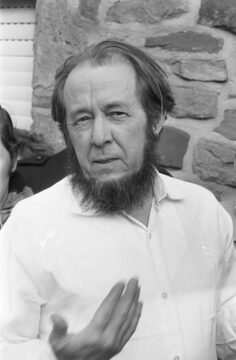 How irreversible, how irreparable is this process of mass vulgarization? Judging by the sphere of literature (the sphere closest to me), the path toward a reestablishment of high quality is not yet closed off, not yet taken from us, even if it will require a significant concentration of abilities and efforts. In principle, and according to the very nature of art—according to its flexibility and multifacetedness—the elite and the popular can coexist in a single work of literature: in successful cases, indeed, that work may be multileveled, written in such a way that it is accessible and satisfactory concurrently for readers of diverse levels of understanding and perception; and if a person experiences an elevation of level over time, he reads the same book with a newer understanding. Failure in achieving this is hardly preordained; but the author has to rise above the day-to-day demands of the publishing market, above calculations of assured near-term success.
How irreversible, how irreparable is this process of mass vulgarization? Judging by the sphere of literature (the sphere closest to me), the path toward a reestablishment of high quality is not yet closed off, not yet taken from us, even if it will require a significant concentration of abilities and efforts. In principle, and according to the very nature of art—according to its flexibility and multifacetedness—the elite and the popular can coexist in a single work of literature: in successful cases, indeed, that work may be multileveled, written in such a way that it is accessible and satisfactory concurrently for readers of diverse levels of understanding and perception; and if a person experiences an elevation of level over time, he reads the same book with a newer understanding. Failure in achieving this is hardly preordained; but the author has to rise above the day-to-day demands of the publishing market, above calculations of assured near-term success.
more here.
Enjoying the content on 3QD? Help keep us going by donating now.
